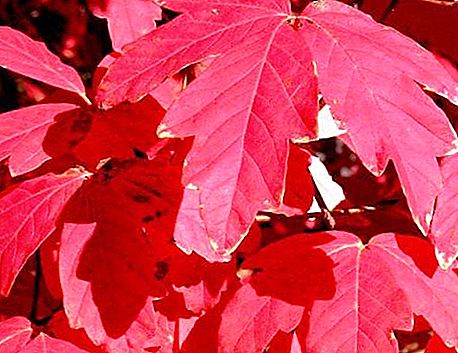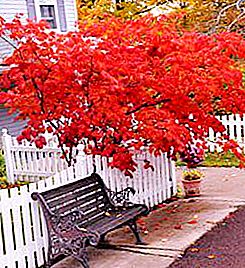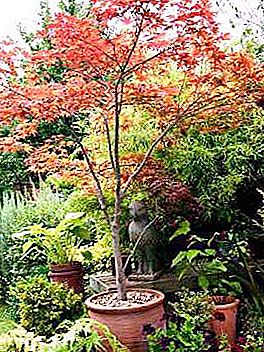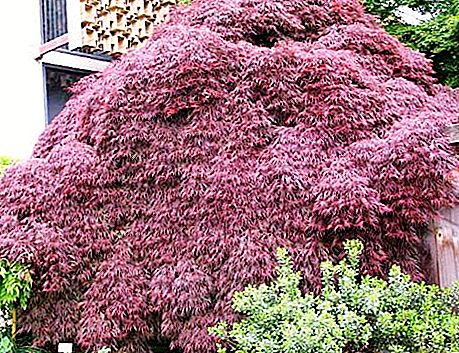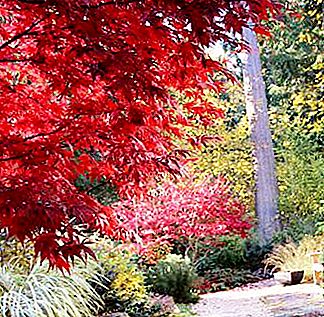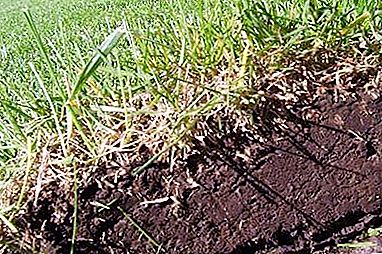Japanese maples are deciduous shrubs and trees that adorn gardens, patios, terraces, and flowerbeds around the world. Red foliage looks attractive, the decorative appearance of plants with purple, orange, maroon crowns is appreciated by professionals in landscape design and amateur gardeners. Japanese maple (red) is a challenge to the author of the phrase "green spaces" that has snapped up. The unusual color of the elegant leaves appeared as a result of natural processes and the painstaking work of breeders.
Maple with red leaves and openwork crown
Japanese maple acquired its spectacular appearance thanks to a complex biochemical composition. From school, many people know about chlorophyll, which gives the leaves a green color. In addition to this pigment, the plants contain carotenoids, their presence is caused by red, yellow and orange color. Violet, brown, orange and red shades of foliage are due to the accumulation of anthocyanins in the cell sap. Beautifully shaped leaf blades can be painted in purple and carmine tones, in harmony with the gray shade of the bark. The crown of the trees is usually round, occurs in the form of an oval or mushroom cap. Dissected leaves of red maples from a distance look like lace. Inflorescences, fruits, even bark patterns - the whole aerial part looks very decorative. In autumn, the leaves acquire brighter shades, and fall in the winter. But the plant continues to delight the eye with the grace of thin branches, an unusual crown.
Decorative red maple
The plant belongs to the Sapindaceae family (lat. Sapindaceae), belongs to the genus Maple. Homeland - forests of Southeast Asia. The variety of small forms of Japanese maples is surprising; in the country of the Rising Sun they have been created for centuries. Now in many countries, breeders are engaged in the cultivation of new cultivars of a popular ornamental plant. Varieties of maples belonging to three species look bright and elegant:
- fan-shaped or fan-shaped maple (Acer palmatum);
- Japanese red maple (Acer japonicum);
- Shirasawa maple (Acer shirasawanum).
In summer, in the gardens and on the terraces, the golden foliage of the maple of Shirasawa attracts attention, in the fall it turns bright orange. Dutch varieties of fan maple in the spring are covered with glossy dark red leaves, which, before falling, change color to orange-red. Openwork crown acquires bright colors in good sunlight or partial shade.
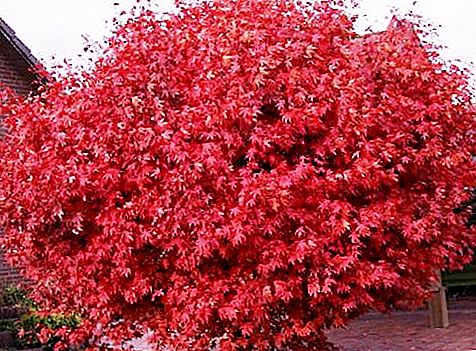
Lane-shaped maple (fan)
Compact in size, the fan-shaped maple red shows a wealth of shades of purple, orange and pink. The native land of this species is the forests of Japan, East China and Korea. Under natural conditions, trees reach a height of 8–10 m. The crown becomes rounded or mushroom-shaped with age. Young shoots of the plant are covered with colored skin. In spring, the leaves turn red, in the summer in some cultivars they turn green, in the fall they turn purple. Flowers are collected in bright friable inflorescences. The shape of lionfish varies greatly among different varieties of fan maple. The plant is thermophilic, demanding on soil fertility and moisture, but does not tolerate excess water. Temperatures below –15 ° C damage the root system. The species is propagated by seeds that can be sown immediately after their collection. Common forms of the cuneiform maple: pink-fringed, crimson, purple, dissected, and others.
Planting red maple
Trees with red leaves look good singly in groups. When planting, the distance between the plants should be left at 1.5–3.5 m. For seedlings, a planting pit is prepared at a depth of 50–70 cm. Good water drainage (sand, gravel, construction waste) must be taken into the wetlands. Red maple seedlings are placed in a recess with a loose layer at the bottom. Fill the landing pit halfway with water and fill it with a substrate, which is mixed with complete mineral fertilizer. There are new varieties that do not exceed a height of 1.5 m, they can grow in containers. Pots for planting should choose ceramic or plastic in the Japanese style. Red maple prefers loose, humus-rich substrates, does not like waterlogging. The soil for containers is mixed with compost in a ratio of 1: 1 or prepared from equal parts of turf land and peat, sand is added.
Japanese Maple Care
Red maples do not require radical pruning, but be sure to remove diseased and dry branches. In spring, care consists of replacing the top layer of compost with a fresh one, previously enriched with fertilizers. The mixture is prepared from 40 g of urea, 30 g of superphosphate and 25 g of potassium salt. The trunk circle can be covered with mulch to preserve moisture and protect against crusting. Watering in the summer must be combined with top dressing and cultivation. Red maple tolerates a lack of moisture, but loses its decorative effect. The watering regime needs to be regulated depending on the climate of the area and weather conditions. Winter hardiness largely depends on the species, variety and age of plants. In autumn, the roots of young trees and bushes on the site should be insulated with dry leaves, and containers should be brought into the room.
Diseases and Pests
Maple, the red leaves of which are pleasing to the eye, can suffer from powdery mildew, coral spotting. Shoots damaged by phytoparasites should be removed, the places of cuts should be covered with garden varnish and disinfected with tools. Before budding, you can conduct treatment with copper sulfate, pollinate with sulfur. Trees and shrubs are attacked by phytophages: maple whitefly, mealybug, leaf weevil. Spraying is carried out at the stage of feeding the larvae with the Aktellik preparation, in the autumn dry leaves are collected and destroyed.
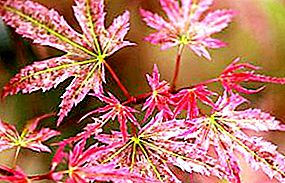
Red Maple Propagation
In autumn, cuttings for vegetative propagation are cut (20 cm). They are instilled in the winter, and in the spring they are rooted in containers or pots. Fill containers with light soil, be sure to mix with sand. In the spring, buds or cuttings of ornamental cultivars are planted on more winter-hardy and fast-growing varieties of the same species (or closely related). For seed propagation, lionfish are collected and sown in the fall in the soil. But it is better to create conditions that resemble stratification in nature, which occurs in winter at a temperature of about 3 ° C. In the spring, the seeds are soaked before sowing, and when they hatch, they are sown in the garden to a depth of 4 cm. In summer, in the heat of seedlings, you need to shade. Seedlings that have reached 50–80 cm can be transplanted to a permanent place.

